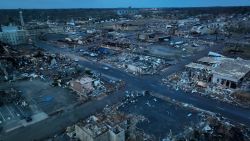Severe weather struck with a violent intensity this weekend, leaving a wide path of death and destruction across eight states.
There were at least 50 reports of tornadoes during the outbreak from late Friday into Saturday in Arkansas, Illinois, Indiana, Kentucky, Mississippi, Missouri, Ohio and Tennessee, according to the Storm Prediction Center.
“The devastation is quite frankly something that you would see in a war zone,” Michael Dossett, director of Kentucky Emergency Management, told CNN on Sunday.
At least 100 people are feared dead.
Authorities are still assessing the damage on the ground, but here are facts that illustrate the power of these deadly storms.
In pictures: Deadly tornadoes hit central and southern US
• Though the death toll is still being determined, at least 64 people were killed in Kentucky alone. That makes it the deadliest 24-hour period in December for tornadoes in the United States, based on records that were first kept in 1950.
• If the total death toll for all states climbs above 90, it will become one of the top 10 deadliest days for tornadoes since 1950, regardless of month.
• More than 100 tornado warnings were issued Friday before midnight, the most tornado warnings ever for a December day.
• One storm cell that was tracked on radar for around four hours, through parts of four states and for more than 250 miles, could end up being the longest continuous tornado in history. The storm became tornadic in eastern Arkansas, southwest of Monette, and tracked through Missouri and Tennessee to Central City, Kentucky. It will take days for the NWS to determine if this was a single tornado on the ground for the entirety or multiple ones.
• The current record for the longest single tornado track is the “tri-state tornado” in 1925, which was on the ground for 219 miles in Missouri, Illinois and Indiana. That tornado resulted in 695 deaths, which is also a record for a single tornado in the United States.
• If any of Friday night’s tornadoes are rated EF-5 (estimated winds of 200 mph or greater), it would end a streak of 3,126 days since the last EF-5, which is the longest stretch without one since the records began in 1950. The last EF-5 tornado was the Moore, Oklahoma, tornado on May 20, 2013.
• December sees fewer than 30 tornadoes on average. There were more than 50 tornado reports in a 24-hour period, but more than one report could have come from the same tornado.
• A vast majority of the tornadoes and fatalities occurred overnight Friday. Research shows nighttime tornadoes are around 2.5 times deadlier as daytime tornadoes.


























































